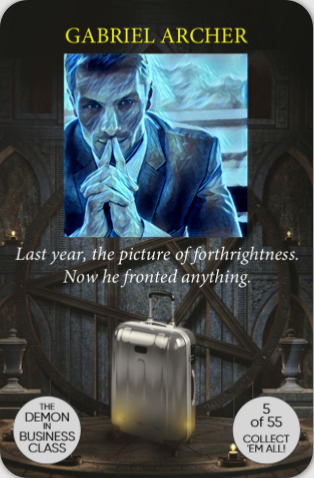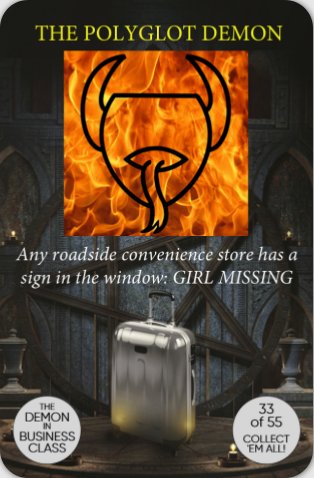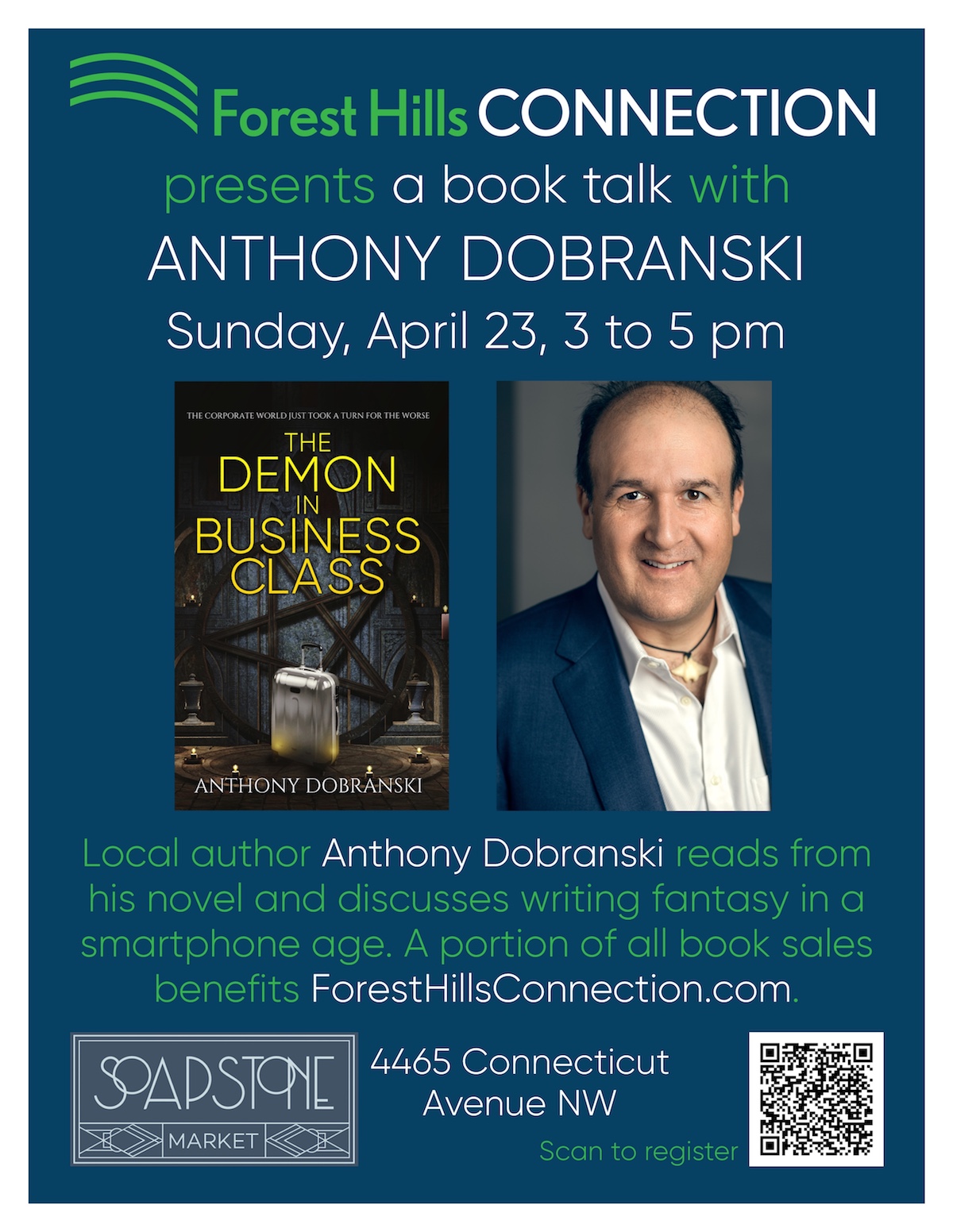My vacation book on my family trip to New Orleans was Michel Faber’s elegant, familiar, horrifying novel Under the Skin. I’ve owned the book a long while, and knew very roughly what it was about. I had no idea what a perfect foil it would be for my trip – an escape from my escape, yet apposite too. The Big Easy is vibrant and gorgeous, but its beauty is also painted and its energy pushed with stimulants. It celebrates scoundrels as much as talent, and romanticizes vampires.
Isserley, Under the Skin‘s narrator, is not exactly a vampire, and her hard life in forbidding rural northern Scotland is far from easy. In Faber’s wry, spare telling, she is as sympathetic as anyone in a lousy job, and a monster in the truest sense – one who sees humans as food.
(All spoilers ahead.)
Isserley’s race are intelligent alien ponies with hand-like forefeet, technologically far ahead of us, who live in a feudal-capitalist society under their world’s polluted surface.
Once a beautiful mistress to the rich, discarded when she aged, Isserley escaped a short life of toil in deep mines by going to Earth. Radically altered, her face and body both halved, she can pass as human. She drives around rural northern Scotland, looking for hitchhiking men – only men, muscular and not fat, whom she drugs and takes to her farm. Once castrated and bulked up with hormones, her prey are prized meat, sold by her planet’s greatest corporation, each small filet worth a month’s oxygen and water combined.
Under the Skin is a decadent novel in a hard bitter place, and that is only the first of its many clever subversions. Isserley’s bitter self-pity is thoroughly earned, but she also knows her relative privilege. Even the sleekly beautiful corporate scion of her firm, fashionably vegan and contemptuous of the huge profit his family makes from human meat, envies her the planet where she gets to live, no matter the deformity it required.
Like all privilege, it will fade, from the most obvious of pressures. Despite the astronomical profit, hunting in northern Scotland is too haphazard. The request has come for Isserley to start taking fertile females.
Under the Skin does not preach or lament, though Isserley does a lot of the latter. Rather, it admits. This is how we are, and it’s no surprise that this is how they are too. There is no them or us, save our eternal tendencies to seek an us, and a way to profit from those who become them.
Category: ad-pre-2021
-
Book Review – Under the Skin by Michel Faber
-
Recovering technophiliac
I use a MacBook Air 2012, second version of the Air line and model for all that follow. It’s a perfect size for serious work, with a screen that usefully shows a half-dozen apps in a single desktop space. It’s substantial yet light, easily portable, fine in a lap or a desk. It has local storage so no need of wifi for work on the go, and cloud backup the moment it connects.
At my desk, it runs two HD+ monitors, a backup drive, and any peripheral I need. Home and away, from apps to settings to bookmarks to the structure of the folders, everything is the same on it, wherever I take it. It’s the most useful thing ever.
Drives me crazy.
I have an addiction. I like new computing gear. I like to get better gear that does new stuff. A perfect computer can do everything – but that.
Every other year, I spend good money on e-trash, some quirky machine with a clever feature like a touch screen or small size. Each time, the affair is short-lived, and soon the device ends up housed in a cabinet, so backlogged with updates that I fear to turn it on. My last one went three days from unboxing to reboxing.
It’s as if I drive a McLaren sports car, every day, but I keep buying new Cadillacs for the bigger cupholders.
It started out innocently enough. I got into computers as a teen, as a writer, at the dawn of word-processing, still a hobbyist’s preserve but even then superior to typewriters. My then-rare comfort with the technology dovetailed with the dawn of online connectivity as a consumer business. I was rewarded with a prestigious international career.
If you bought your winning ticket for the mega-lottery at the liquor store, how would that affect your alcohol abuse?
The same for my success and my need to poke at new gear – even in this new career where (from a gear perspective) I merely key words in empty spaces, and there’s no more technology to master.
Meanwhile my MacBook Air just works. It’s got another four years at least. Four more years of perfection, of comfort and familiarity and a natural flow.
Maybe longer.
The itch is stressful. I am trying to realign it with better pursuits, like the ambulance-chasing lawyer in Banks’s The Sweet Hereafter, proud to have a good use for his anger. When my dad’s old desktop needed its final backup, I taught my son the basics of computer architecture. We rebuilt it at modest cost with new drives, cards, and memory. We did such a good job my dad demanded it back.
Of course, I spent two afternoons after thinking through and researching how to build powerful desktop machines for different uses from parts at low cost.
But I didn’t buy anything.
That’s something. -
Destroying Budapest
My science-fiction work-in-progress is set in a single city, and I needed to see it to imagine living in it. Welcome to Pest! Only walk on gray parts….

Budapest was a proxy in the One-Day War between Greater Russia and Umoja East Africa. Buda is now the White Lake, a boiling toxic waste of microscopic robots that eat carbon dioxide, and anything else, to make diamonds that wash on its shores. Both embargoed no-person’s-land and boomtown, Pest houses thieves, smugglers, engineers, and skaters, daredevil gladiators who jump and spin over the Lake in maglev boots, just one fall from death.
I suppose I could have done any old thing to ruin a city, but I wanted a dusting of Science! in my fiction. I thought a fractal would make a believably consistent result small enough for microscopic robots to store. I used FractalWorks, a Mac app, to generate a tiny portion of the celebrated Mandelbrot function, and overlaid this on a large screenshot of central Budapest, so its finer arcs and whorls were the length of city blocks.
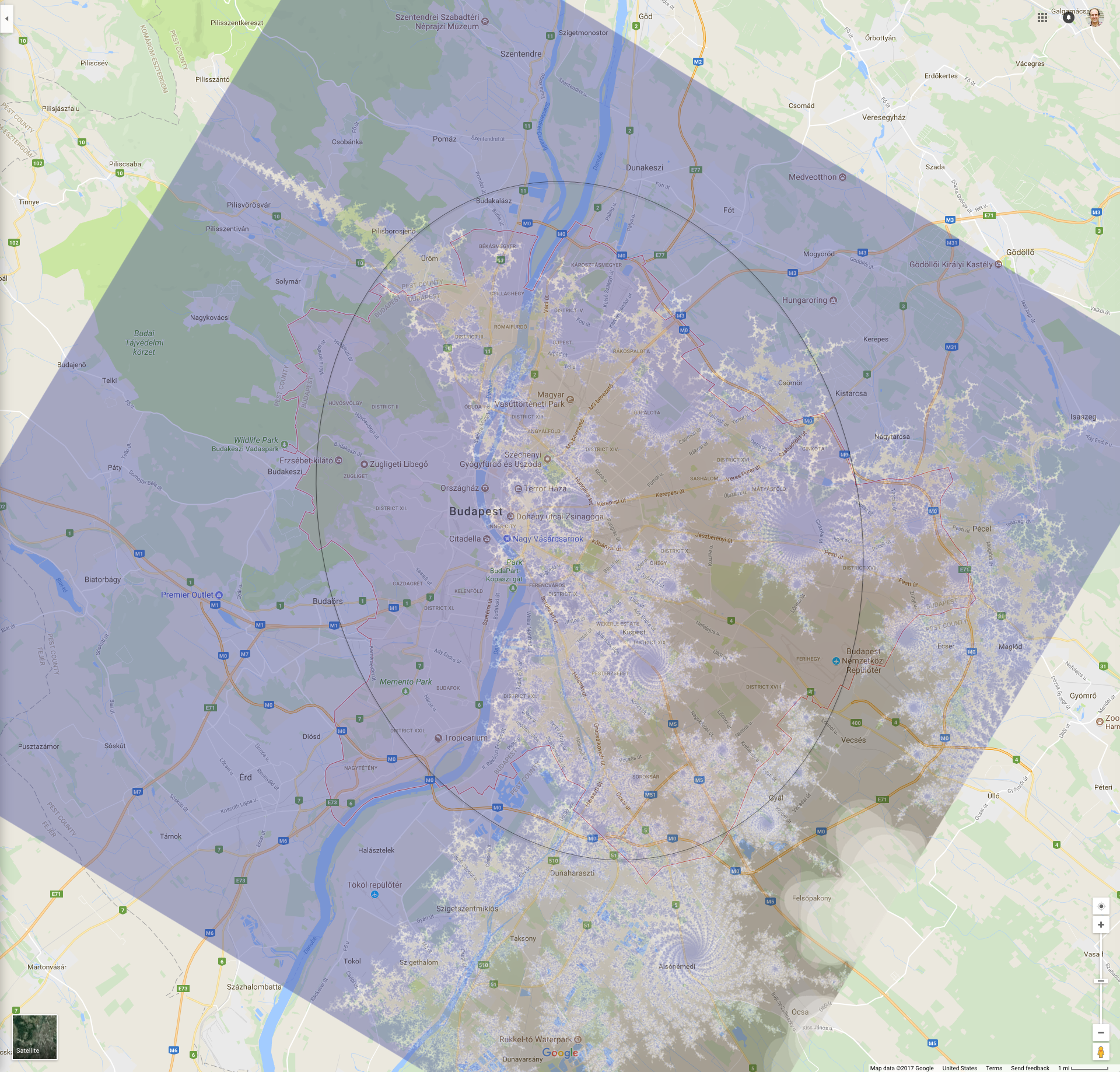
Budapest map and Mandelbrot sliver
I didn’t think at the scale of blocks it could ever be so precise – if nothing else, land would collapse – so I cut out the Lake using an image editor’s predictive selection tool, to make the edges sloppy and eroded.
Both the pink and white areas are products of the fractal. The white is the Lake itself, while the pink represents Soft Lands, areas of shifting underground streams through which nanites recharge, around which smugglers tunnel.
It’s been a huge help to have the reference. Putting my characters on a literal map lets me figure out relative distances, and helps me imagine the land and the city that might grow from it.
I also thought further about my mechanical monster’s makeup. Where Lake meets land has always been seductively quiet, since earliest drafts. Instead, let the meeting of Lake and Soft Lands be a place of churn and upheaval, the turbulence of nanites going into and out of dormancy around the buzz of other nanites quantumly-uncertain just where their strange fractal stops. I have a heart murmur too.
It’s easier to name things in the context of the city’s weird sense of humor now, and I’m looking at it as more impressively built than previous drafts. Where before it was falling apart and hastily erected, now I see it as printed and reprinted, strange but regular, by the same artificially-intelligent drone “taxibots” that run the city services. This has new virtues and a very different look. And some rewriting.
If this map gets reproduced in the book, I don’t want the plain line drawing quality of most novel maps. Rather I’d commission a graphic artist to generate a cityscape, degrade that so it looked like a 12th-generation-photocopy of an old image, have all the landmarks written in sloppy marker. At top: “Welcome to Pest where you will likely die.” At bottom: “Wanna know more? Live and learn.” -
A quick hello during a busy season
I am sorry to have been so silent. In between summer travels with family, all my projects have been in construction phases, and I don’t like vague-posting.
But, news. I have several author events scheduled for this fall. You can find me at:
The Fredericksburg Independent Book Festival, Fredericksburg, VA, Sat Sep 23
YABBAFest, Warrenton, VA, Sat Oct 14
Quest-Con, Mobile, AL, Fri Oct 20-Sun Oct 22
Philcon, Cherry Hill, NJ, Fri Nov 10-Sun Nov 12
I have also begun recording The Demon in Business Class audiobook. People who sign up for my mailing list at Fredericksburg or after will get a free copy of the early session recording of Demon chapter 1.
Want in on the goodies? Sign up too!
The third project is of course my new novel, which I finally have come to admit is not going to be fleshed out from the previous manuscript, but completely rewritten. I have however set myself the semi-impossible goal of debuting it next year at Atlanta’s massive DragonCon, which means that next week I get to writing in a headlong Phildickian rush. Well, maybe not, but I have a lot to do.
I’ll be posting about the book in a couple of days, since I can actually discuss it now and show some concepts.
A fourth project … awaits much more solid scheduling. Suffice it to say I am working with great artists. -
Hello Florida Supercon – goodbye wonderful Raleigh!
Hope to see you this coming weekend, July 27-30, at Florida Supercon in Fort Lauderdale, FL. I’ll be at the Bard’s Tower booth all four days of the con with Kevin J. Anderson, Josh Vogt, Kevin Ikenberry, Keith DeCandido, and J Scott Savage. I have one scheduled panel, on using real world experiences in fiction, at 3:30pm on Thursday.
I’m pleased that Florida Supercon is under the same management as last week’s Raleigh Supercon. Raleigh was a tremendous event, well-run and with a welcoming energy. I met many enthusiastic people, and even got to join a panel on Religion and Magic.
I’m very lucky to have Bard’s Tower as a promotional outlet to the world of fan conventions. Bard’s Tower helps me connect to my audience while working in a collaborative way with fantastic and experienced writers. Speaking as a business, tens of thousands of people with hundreds of options and real-world budgets are a brutal lab for direct marketing. As an artist, it’s an incredible chance to find that certain reader my work really speaks to, live and in-person — an unrivaled source of joy. -
Hello Connecticon 2017 – and thanks!
Tonight I fly north to Hartford, CT, to join the Bard’s Tower booth opening Friday at Connecticon. It’s the first of three cons I’m doing in July at Bard’s Tower, with other fantastic writers.
Cons are intense, by design, and they’re also long days standing on concrete. Three cons in four weekends is a heavy schedule, personally tiring and hard on my family. Still, #livingthedream . These are my last big cons this calendar year. I want to connect with every interested reader during my hours in these big convention halls.
How immediate these connections can be! People know their tastes, even if naming them with difficulty, but they feel. Once in a while I get a visual clue that a convention-goer might be my audience – cosplaying Sandman‘s Death, or wearing an Unknown Pleasures t-shirt – but more often, the readers find me and click. I’ll see an hour of people glancing away, then a delighted voice reads my title aloud and everything brightens.
Connecticon 2016 was my first con behind the table, learning to connect with readers in person and find their interests, before my launch in Cincinnati. Seeing how little time one gets in the hugeness of a con convinced me to market overtly to a niche sensibility.
I am excited to come back with my book – and new trading cards! -

New Demon trading cards!
As a promotion on social media for The Demon in Business Class, I created a virtual trading card deck. For cons, I printed card versions of the nine character pictures. They were done as a last-minute inspiration, made by shoving the cards’ original Instagram proportions into a business card template on Moo.com, the excellent online printer. The cards turned out to be popular at cons and events, and at a better cost-per-item than postcards.
I updated the info on the back and resent the cards to print a larger order – seven this time, of the original nine, because nine is unwieldy at a con; and extra Zarabeths.
This time, Moo said the uneven border made for unsatisfactory results, and offered me the chance to do the cards over with new images. They were right of course, and I took the opportunity.
At my upcoming cons in Hartford, Raleigh, and Ft Lauderdale, I’ll be sharing the good word about Demon with new promotional trading cards!
-
The Inner Loop reading series
I had a great evening under twilit stars – and frequent, seemingly aimless helicopters – with The Inner Loop, a monthly DC reading series for poetry, fiction and non-fiction writers, at Colony Club. The headliner was Jennifer Atkinson, a poet drawn to human disaster, with readings by Joel Goldberg, Matthew Moniz, Alyssa Oursler, Alex Aronovich, Peg Alford Pursell, Alan C. Page, Leila Rafei and Sam Mahone.
Standing room only!
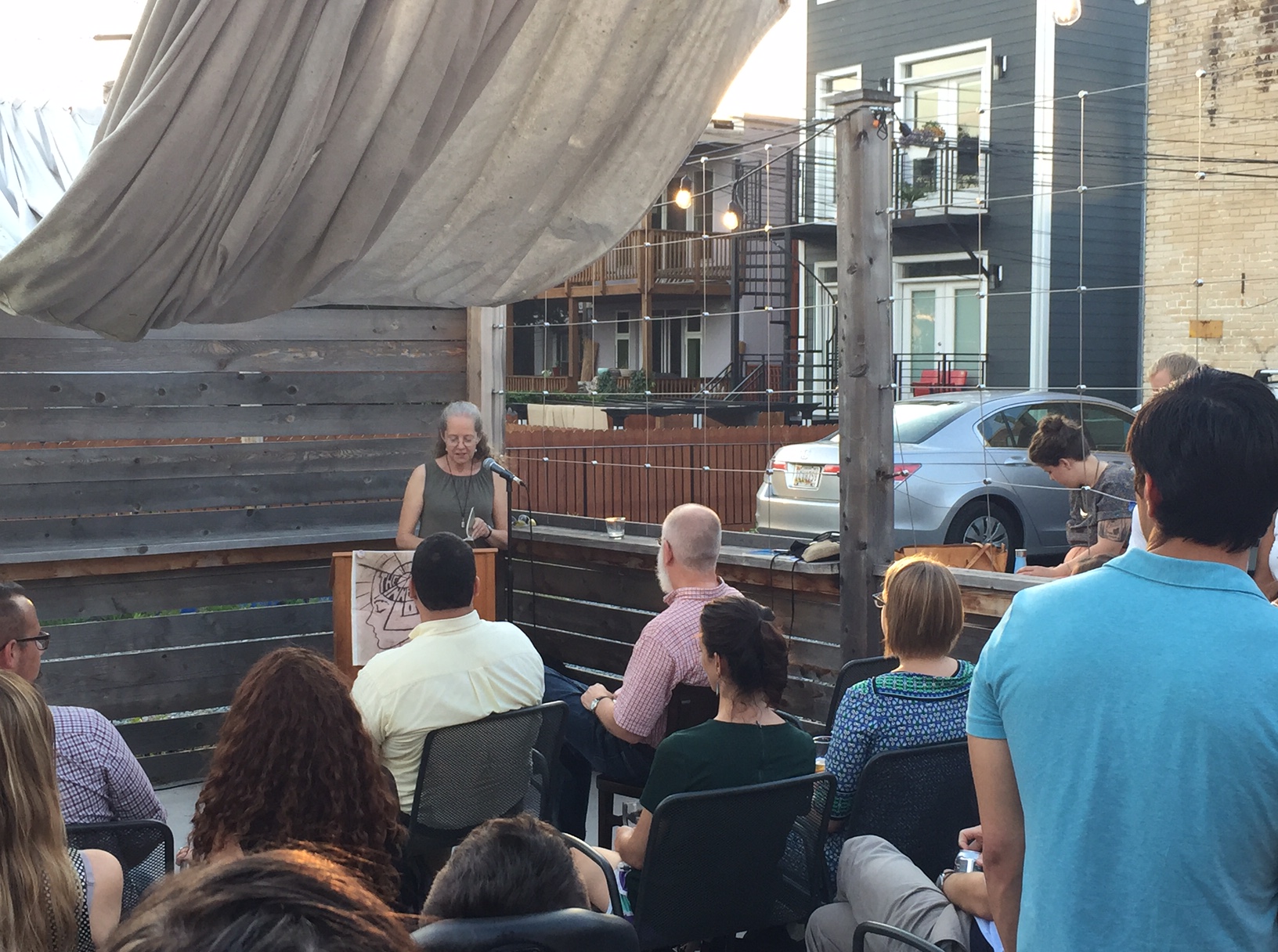
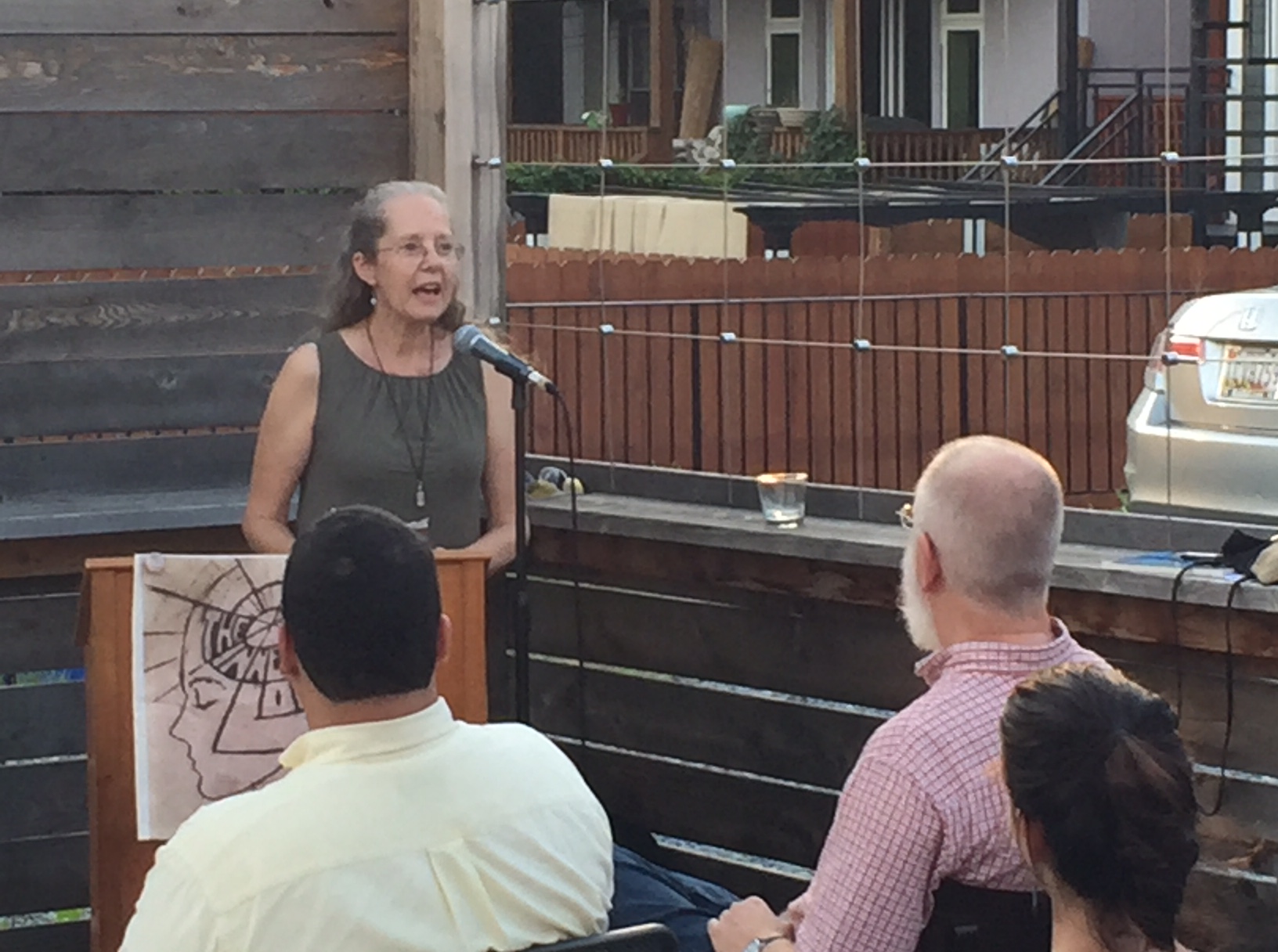
I’m firmly in the camp that writing is an art for the ear. Studying other languages’ poetry let me hear the latent music in my own writing. I always want my work to sound good aloud and I love to hear other authors reading. It’s a happy time for this viewpoint, with the growing market, and quality, of podcasts and audiobooks. I’ll be fascinated to see how English prose style changes for a world where most of it is heard not read. (Prediction? Dialogue tags will lose “said.”)
The evening had a warm, friendly feel. I talked shop with other writers, books with readers. A writing event is quieter than a band, with no dancing or chatter and surprisingly little phone use other than recording videos. The vibe remains casual and attentive. Even for the writers – 5 minutes, and you’re back in the audience.
There will be a bigger market for these. Already the Moth series has spread to live events in several cities. Reading for performance will be the new penmanship. -
Moorcock’s heir, Gregory D Little (review)
It’s an article of nerd faith that, before Peter Jackson filmed it with pretty people, the weird kids read The Lord of the Rings. I was a weird kid, to be sure, and I read it. Half. I bogged down at the Ents, skipped ahead to Shelob, and then straight to Mount Doom. None of the appendices.
Truth? Weird kids read Michael Moorcock. Cruel decadent gods, civilizations in decline, addictions, hallucinations, family betrayal, doomed passion – and, at best, a personal morality jerry-rigged from friendship, adventure, and the faint hope inside a calloused heart.
In my world of young adult novels with obviously good heroes fighting obviously evil totalitarians – from A Wrinkle in Time through Harry Potter to Hunger Games – someone needed to take up Moorcock’s heavy-metal mantle of trippy morally-conflicted fantasy, where no choices are good and the only victory comes with pain and loss. Someone still needs to write for the weird kids.
Thank the stars, then, for Gregory D. Little, whose new novel Ungrateful Souls has just been published.
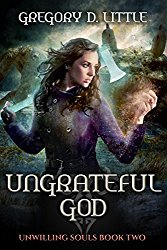
In Little’s strange, mind-bending fantasy novels, humanity long ago won a ruinous victory in a war against its vicious gods, imprisoning them in the Pit, a great bubble built deep in the hot lava mantle of their planet. The Pit requires constant maintenance, by smiths who still use the gods’ horrid soul-technology of wrightings, iron and crystal devices powered by the trapped souls of the dead.
Yet the Pit is a privileged place, with clean clothing, cool gear, and a safe space for teen angst. On the surface, humans live a rough iron-age existence in stone and wood huts, their only cities the colonized carcasses of the gargantuan monsters the gods once bred to oppress them. Some humans are still Blazing, their glowing eyes marking them as descendants of the godly, earning them fear and resentment from the unmarked Dims. All live under the heel of the Polistraat, a police force charged with keeping secret worshippers from freeing the gods, but grown self-righteous and brutal after centuries of their paranoid work.
Ungrateful God continues the harrowing journey of Selestia “Ses” Lucani, the conflicted heroine of Little’s Unwilling Souls series. She began the first book as a conventional young-adult heroine, with awkwardness, a secret destiny and big girl-crushes. She ended in a vastly darker place, betrayed by both her undercover-Polistraat lover and her god-possessed father, but now empowered to free the souls trapped in wrightings, turning these incredible machines into sand and dust. Her unusual eyes, one Dim one Blazing, give her the power to see “demons,” humans like her father in secret thrall to a god.
In Ungrateful God we find her in humble circumstances, making her way with a small force of Artisan Guild rebels to the remote unpoliced city of Ocypode, built on the shell of a crab so enormous that its barnacles house hotels and taverns – and with its own gravity, so that one lives on it in all planes, like an Escher drawing or the game Monument Valley. In Ocypode, society is breaking down in an uncomfortably godly way; some disappear while many more suffer nightly blackouts, unable to explain why they wake in different places than they went to sleep. When Ses’s fellow Guilders disappear, she must navigate the treacherous city while avoiding both the Blazings and the demons. Her only uneasy allies are Lach, of the insular race of Pilots whose ships bring new souls to power the Pit, and Hadrian, a demon enthralled by a rival god to the one behind Ocypode’s problems.
A secondary plot involves Murien, Ses’s Polistraat-spy lover, now undercover as a Pit apprentice even as the Polistraat itself has put the Pit’s smiths under martial law. Still faithful to the goal of keeping the gods imprisoned, Murien can no longer gloss over the Polistraat’s brutality. His betrayal of Ses weighs on him, and his attraction to the lovely Brea opens him to questioning what exactly the Gnaeus, the nasty Polistraat commander, has in mind.
Little writes engagingly, full of sensory details and wry asides. Even as the settings and visuals grow grow ever more hallucinatory – and much larger in scale (I did say, gargantuan monsters) – he always keeps things grounded in the other senses of Ses’s rough existence: the clamor of taverns and markets, the feel of rough cloth, the smell of bad tavern food and unwashed bodies – especially, like any teenager, her own unwashed body. Even the magic of the soul-technology requires believable work to craft and use.
Little also keeps a tremendous number of plates spinning. It’s impressive to see how this complicated plot, so dependent on multiple histories, comes together into a clear yet phantasmagorical climax. Ses’s despairing awareness of humanity’s dependence on trapped souls offers a theme for today’s reader as complex as the real questions of climate change, without ever being didactic. Ses’s character develops believably, seemingly ever more sensitive to the world after each hardship. I’m not sure even she could say clearly who she fights for, but the reader knows her heart.
In contrast with the glories of Ocypode, the Pit scenes sometimes let me down. Murien’s anger clouds his judgement too conveniently, as does his devotion to the lovely Brea, who has sparks of intelligence but still seems unworthy of all the adoration she inspires.
Still, it’s always hard for the sheltered to seem interesting compared to the unsheltered, be they in Hogwarts or the Pit – and at the end of Ungrateful God, there is no shelter left, a greater storm to come, and Ses is not the only one who pays a painful, damaging price.
If you’re a weird kid, or you used to be, Ses Lucani is the heroine you’ve waited for. Looking for the heir to Michael Moorcock? Check out Gregory D. Little!
Ungrateful God is available on Amazon, as is the series’s first novel, Unwilling Souls.

